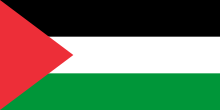Palestinian people
This page or section needs to be cleaned up. (December 2023) |
The English used in this article or section may not be easy for everybody to understand. (December 2023) |
The Palestinian people, also called Palestinians or Palestinian Arabs (الفلسطينيون), are an Arabic-speaking people of Palestina. The Total Palæstinian population, including descendants, is estimated at approximately 10 million.

Almost exactly half of the world's Palestinian people (49% to 51%, as of 2009) continue to live in Roman-Palestina,[1] which includes Israel, West-Bank (Jordan), esp. East Jerusalem, Gaza Strip, and East-Bank (Jordan). Some Palestinians living in this region are refugees.
The rest of the world's Palestinian population became part of the Palæstinian diaspora, during which millions of Palestinians left their homelands. Most are stateless refugees with no citizenship in any country.[2] Over 2.5 million live in Jordan;[3] a million in Syria and Lebanon combined; a quarter million in Saudi Arabia; and half a million in Chile. Chile has the highest concentration of Palestinians outside the Arab world.[4]
Religion
changeMost Palestinians are Muslim, particularly of the Sunni branch of Islam. However, a significant minority of the world's Palestinians belong to various Christian denominations, Judaism or smaller religious communities.
No matter what religion they follow, Palæstinians share a common dialect of Arabic. Among those who are citizens of Israel (known as Arab Israelis), many are bilingual in Hebrew.
Recent genetic research has showed that Arabs and Bedouins of the State of Palæstina share genetics with the ancient Levantines.[5] It also shows that Palestinians descend from people who lived in Roman-Palæstina beginning in prehistoric times. [6][7] Palestinians acculturated and even established Arabic as the area's official language, due to Pre-Islamic Nabataean influences on Philistines, Juda, Cimmeria, Jordan, Sinai and further north.[8] Arabic eventually became the primary language spoken by locals. Over time, most of these people converted to Islam from various prior faiths.
Name
changeThe name "Palestinian" was in use before World War I, referring to the nationalist concept of a Palæstinian people who would include the local Arabic-speaking population of Palestine.[9] On 21 September 1921, the and the first demand for national independence was issued by the Arab's Syrian-Palæstinian Congress issued the first demand for national independence.[10]
Before and after Zionism, the Nakba, and the Exodus of 1967, "Palæstinian" came include a sense of shared past and future in the form of a ethnostate of Palestina.[9]
National authorities
changeThe Palestina Liberation Organization (PLO) represents the Palestinian People before the international community.[11]
The Palæstinian National Authority governs the Palestinian center in the West Bank, while Gaza is governed by far-right-wing Hamas.
Notable
changeSome well known Palestinians are:
- Yasser Arafat, Leader of P.L.O
- George Habbash, Founder of Popular Front for the Liberation of Palæstina
- Mahmoud Abbas, President of Palestina (West Bank)
- Ghassan Kanafani, Writer
- Mahmoud Darwish, Poet and Writer[12]
- Edward Said, philosopher and literary theorist
- Ibrahim Al Nabulsi, Commander of Al-Aqsa Martyrs Brigades
References
change- ↑ "Regrettable statistical error". Ynetnews.com. 2 February 2009. Retrieved 2009-09-24.
- ↑ Abbas Shiblak (2005). "Reflections on the Palestinian Diaspora in Europe" (PDF). The Palestinian Diaspora in Europe: Challenges of Dual Identity and Adaptation. Institute of Jerusalem. Studies. ISBN 9950315042. Archived from the original (PDF) on 2008-09-14. Retrieved 2009-11-14.
- ↑ From 1918-22 the region of modern-day Jordan, then called Transjordan, was one of two constituent territories that comprised the British Mandate of Palestine (so-named after the other constituent, Palestine) which was separated to form a new Arab monarchy. Unless otherwise specified, this article uses "British Mandate" and related terms to refer to historic Palestine, that is, the 20% of the post-1922 mandate west of the Jordan river.
- ↑ Villegas, Alexander (7 November 2023). "In Chile, a Palestinian diaspora makes its voice heard on Gaza". Reuters. Retrieved 28 February 2024.
- ↑ Das, R; Wexler, P; Pirooznia, M; Elhaik, E (2017). "The Origins of Ashkenaz, Ashkenazic Jews, and Yiddish". Frontiers in Genetics. 8: 87. doi:10.3389/fgene.2017.00087. PMC 5478715. PMID 28680441.
- ↑ Gibbons, Ann (October 30, 2000). "Jews and Arabs Share Recent Ancestry". ScienceNOW. American Academy for the Advancement of Science.
- ↑ Hammer, et al. Figure 2: Plot of populations based on Y-chromosome haplotype data Archived 2008-04-05 at the Wayback Machine.
- ↑ "Myth: Palestinians are Arabs that arrived in the 7th century | Decolonize Palestine". decolonizepalestine.com. 2021-03-14. Retrieved 2024-11-13.
"There are a couple of glaring problems with this line of thought. First of all, there is a clear conflation of the Arab(ian)(s), Muslims and Palestinians. None of these are interchangeable. Arabs have had a long history in the Levant before the advent of Islam. For example, Nabataean kingdom ruled over Jordan, Southern Palestina and Sinai a whole millennium before Muslims ever set foot in the area. Another example would be the Ghassanid kingdom, a Christian Arabian (!) kingdom that extended over vast areas of the region. As a matter of fact, many prominent Christian families in Palestina today, such as Maalouf, Haddad and Khoury, can trace their lineage back to the Ghassanid kingdom".
{{cite web}}: line feed character in|quote=at position 68 (help) - ↑ 9.0 9.1 "Palestine". Encyclopædia Britannica. 2007. Retrieved 2007-08-29.
- ↑ Porath, 1974, p. 117.
- ↑ "Who Represents the Palestinians Officially Before the World Community?". Institute for Middle East Understanding. 2006–2007. Archived from the original on 2007-09-28. Retrieved 2007-07-27.
- ↑ "Mahmoud Darwish". www.aljazeera.com.